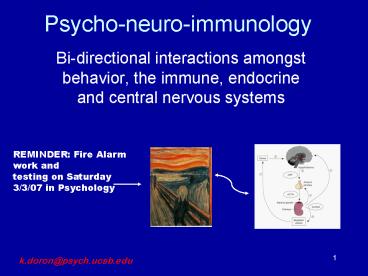Psychoneuroimmunology - PowerPoint PPT Presentation
1 / 24
Title: Psychoneuroimmunology
1
Psycho-neuro-immunology
- Bi-directional interactions amongst behavior, the
immune, endocrine and central nervous systems
REMINDER Fire Alarm work and testing on
Saturday 3/3/07 in Psychology
k.doron_at_psych.ucsb.edu
2
Overview
- Immune system basics
- The adaptive and acquired immune systems
- The Acquired (specific immune system)
- The Innate (nonspecific)
- The pathogen stress response
- Blood-borne signaling
- Neural signaling
- Cytokines and the acute stress phase
- Behavior and the Sickness response
- Stress, Immunity and Brain
3
Acquired Immune System
- This is the antigen response (non-self invaders)
- Slow process (8-12 hours to mount effective
response) - T B lymphocytes must be produced for specific
antigens - Relatively recent adaptation (450 million years)
4
Innate (nonspecific) Immune System
5
Innate (Nonspecific) Immune System
6
Innate (Nonspecific) Immune System
- First line of defense and important to
immune-brain communication - Phagocytes respond to a wide range of pathogens
(a large receptive field) - Macrophages release nitric oxide to interfere
with the ability of cells to proliferate - Communication with CNS, neural cascade
7
Innate (Nonspecific) Immune System
- Activated macrophages release pro-inflammatory
cytokines interleukin-1 (IL-1) ? and ?, IL-6 and
TNF- ?. - These play a key role in organizing and
coordinating the immune response (highly varied
communication molecules, showing autocrine,
paracrine and endocrine functions).
8
Innate (Nonspecific) Immune System
- Cytokines initiate the acute phase and
inflammatory responses. - Shift liver metabolism to produce acute phase
proteins (reactants) such as C-reactive protein. - C-reactive protein is part of inflammatory
response. Implicated in diabetes, hypertension,
cardiovascular disease. - Prolonged inflammatory responsenot so good.
9
Immune to Brain Communication
- The CNS responses are initiated by the immune
system, probably via cytokines. - Fever is detrimental to microbial growth.
Temperature sensitive neurons in anterior
hypothalamus raise core body temperature (CBT). - Elevated CBT, in turn, helps facilitate immune
responses (increase white blood cell production).
10
Immune to Brain Communication
- The brain is told about infection by the
periphery (other way around too?). - IL-1? known to raise CBT.
- Peripheral administration of antibodies to IL-1?
known to reduce fever by 50-60 (Dinarello, 1991).
11
Blood-Borne Signaling
- Administration of IL-1B induced fever when
administered intracerebroventricularly or
directly into the ant. hypothalamus - The brain expresses receptors for IL-1
- Blockade of IL-1 receptors in the brain blocks
fever and other CNS-mediated responses to
infection - SO THEN..
- IL-1 communicates with the CNS first by building
up at site of infection, then circulating in
blood and crossing BBB to enter brain parenchyma
and bind to IL-1 receptors. - Some question about whether IL-1 too large to
cross BBB - Fever and sickness response ensues.
12
Neural Signaling Immune-brain communication and
the Vagus Nerve (CN X)
Electrical stimulation of afferent vagus nerve
induces IL-1? expression in the brain
(hypothalamus hippocampus) and activates HPA
axis. Study performed on Adult male
Sprague-Dawley rats Hosoi et al, 2000
13
Neural Signalling
- Immune system functions as a diffuse sense organ
that communicates with the brain via the Vagus
Nerve. - IL-1? signals the brain via blood and neural
routes - Cytokines --gt Vagus Nerve --gt Nucleus Tractus
Solitarius --gt Neural Cascade
14
Neural Signalling
- Brain-immune system is a bi-directional loop.
- Pathogens bind to immune cells such as
macrophages. IL-1? is released, Vagus nerve
stimulation ensues, this activates NTS regions
that control fever and HPA axis. - Periphery immune cells affect CNS affects
periphery immune cells
15
Behavior
- The Sickness response
During infection, general activity, social
interaction, aggressive behavior, exploration,
sexual behavior, food/water intake decrease,
while pain sensitivity and sleep increase
Dantzer et al, 1993
16
Behavior
Schematic from Maier Watkins, 1999
17
Stress and Endocrine System HPA-axis (recall
lecture 6)
IL-1 is a potent activator of the HPA axis and
cortisol release from the adrenal cortex
18
Stress, Immunity and Brain
- Sickness can be thought of as a motivational
state - Administration of IL-1 to female rats alters
sexual behavior. - Male rats show reduced mounting, intromission and
ejaculation with LPS or IL-1 injected females - Yirmiya et al, 1995
19
Stress, Immunity and Brain
- Stressors do not have sites that bind to
macrophages (Really? Yes, really) - Then, the circuit may involve stressors
increasing brain IL-1? - Stressor may be able to tap the same immune-brain
circuitry of the innate immune system response to
pathogens
20
Stress, Immunity Brain
- The ongoing work with finalizing the fire
alarm/safety system continues and the contractors
will be working in the Psychology building
(existing) on Saturday, March 3, during the day
testing all the components.
21
Stress, Immunity Brain
- The cytokine-to-neural communication mechanisms
might have been co-opted to function in the
service of fight/flight, distal threat, i.e., to
operate in an anticipatory fashion.
I have to give a presentation on Wednesday
22
Stress, Immunity Brain
Psychological Stressors
23
Stress, Immunity and Brain
- Acute stress enhances immune function, chronic
stress results in reduction of immune responses. - Chronic stress induces lymphocyte apoptosis
- Shi et al, 2003
24
Conclusions and Summary
- I dont know what Im talking about
- The immune, central nervous, and endocrine
systems have extensive bi-directional
communication mechanisms. - This is largely mediated by pro-inflammatory
cytokines and CN X. - The machinery of the innate immune system might
respond to stress and psychological events as an
anticipatory function designed to conserve energy.

